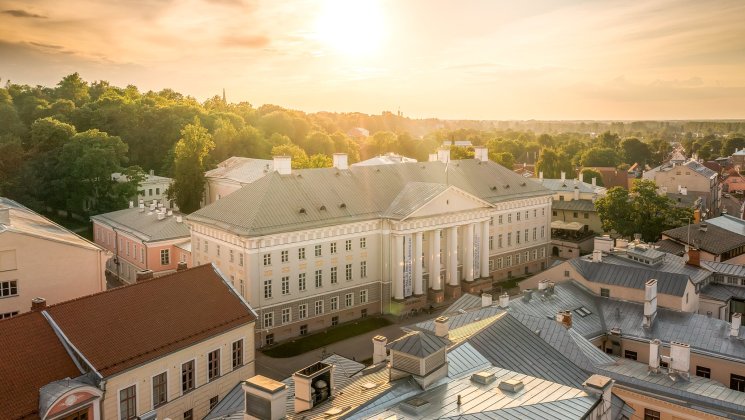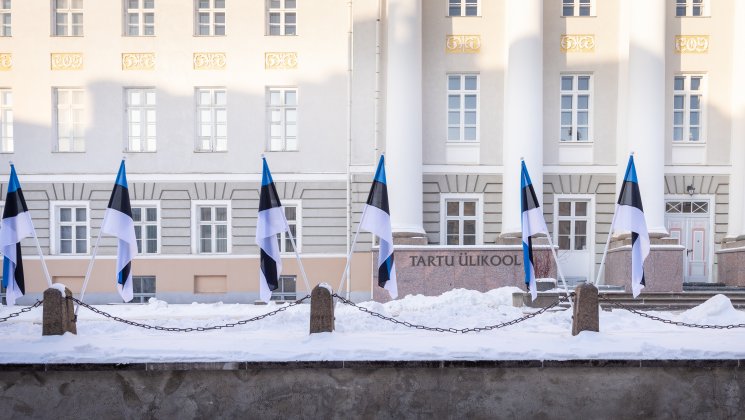-
Faculty of Arts and HumanitiesDean's Office, Faculty of Arts and HumanitiesJakobi 2, r 116-121 51005 Tartu linn, Tartu linn, Tartumaa EST0Institute of History and ArchaeologyJakobi 2 51005 Tartu linn, Tartu linn, Tartumaa EST0Institute of Estonian and General LinguisticsJakobi 2, IV korrus 51005 Tartu linn, Tartu linn, Tartumaa ESTInstitute of Philosophy and SemioticsJakobi 2, III korrus, ruumid 302-337 51005 Tartu linn, Tartu linn, Tartumaa EST0Institute of Cultural ResearchÜlikooli 16 51003 Tartu linn, Tartu linn, Tartumaa EST0Institute of Foreign Languages and CulturesLossi 3 51003 Tartu linn, Tartu linn, Tartumaa EST0School of Theology and Religious StudiesÜlikooli 18 50090 Tartu linn, Tartu linn, Tartumaa EST0Viljandi Culture AcademyPosti 1 71004 Viljandi linn, Viljandimaa EST0Professors emeritus, Faculty of Arts and Humanities0Associate Professors emeritus, Faculty of Arts and Humanities0Faculty of Social SciencesDean's Office, Faculty of Social SciencesLossi 36 51003 Tartu linn, Tartu linn, Tartumaa EST0Institute of EducationJakobi 5 51005 Tartu linn, Tartu linn, Tartumaa EST0Johan Skytte Institute of Political StudiesLossi 36, ruum 301 51003 Tartu linn, Tartu linn, Tartumaa EST0School of Economics and Business AdministrationNarva mnt 18 51009 Tartu linn, Tartu linn, Tartumaa EST0Institute of PsychologyNäituse 2 50409 Tartu linn, Tartu linn, Tartumaa EST0School of LawNäituse 20 - 324 50409 Tartu linn, Tartu linn, Tartumaa EST0Institute of Social StudiesLossi 36 51003 Tartu linn, Tartu linn, Tartumaa EST0Narva CollegeRaekoja plats 2 20307 Narva linn, Ida-Virumaa EST0Pärnu CollegeRingi 35 80012 Pärnu linn, Pärnu linn, Pärnumaa EST0Professors emeritus, Faculty of Social Sciences0associate Professors emeritus, Faculty of Social Sciences0Faculty of MedicineDean's Office, Faculty of MedicineRavila 19 50411 Tartu linn, Tartu linn, Tartumaa ESTInstitute of Biomedicine and Translational MedicineBiomeedikum, Ravila 19 50411 Tartu linn, Tartu linn, Tartumaa ESTInstitute of PharmacyNooruse 1 50411 Tartu linn, Tartu linn, Tartumaa ESTInstitute of DentistryL. Puusepa 1a 50406 Tartu linn, Tartu linn, Tartumaa ESTInstitute of Clinical MedicineL. Puusepa 8 50406 Tartu linn, Tartu linn, Tartumaa ESTInstitute of Family Medicine and Public HealthRavila 19 50411 Tartu linn, Tartu linn, Tartumaa ESTInstitute of Sport Sciences and PhysiotherapyUjula 4 51008 Tartu linn, Tartu linn, Tartumaa ESTprofessors emeritus, Faculty of Medicine0associate Professors emeritus, Faculty of Medicine0Faculty of Science and TechnologyDean's Office, Faculty of Science and TechnologyVanemuise 46 - 208 51003 Tartu linn, Tartu linn, Tartumaa ESTInstitute of Computer ScienceNarva mnt 18 51009 Tartu linn, Tartu linn, Tartumaa ESTInstitute of GenomicsRiia 23b/2 51010 Tartu linn, Tartu linn, Tartumaa ESTEstonian Marine Institute0Institute of PhysicsInstitute of ChemistryRavila 14a 50411 Tartu linn, Tartu linn, Tartumaa ESTInstitute of Mathematics and StatisticsNarva mnt 18 51009 Tartu linn, Tartu linn, Tartumaa EST0Institute of Molecular and Cell BiologyRiia 23, 23b - 134 51010 Tartu linn, Tartu linn, Tartumaa ESTTartu ObservatoryObservatooriumi 1 61602 Tõravere alevik, Nõo vald, Tartumaa EST0Institute of TechnologyNooruse 1 50411 Tartu linn, Tartu linn, Tartumaa ESTInstitute of Ecology and Earth SciencesJ. Liivi tn 2 50409 Tartu linn, Tartu linn, Tartumaa ESTprofessors emeritus, Faculty of Science and Technology0associate Professors emeritus, Faculty of Science and Technology0Area of Academic SecretaryHuman Resources OfficeÜlikooli 18, ruumid 302 ja 304 50090 Tartu linn, Tartu linn, Tartumaa EST0Area of Head of FinanceFinance Office0Area of Director of AdministrationInformation Technology Office0Administrative OfficeÜlikooli 17 (III korrus) 51005 Tartu linn, Tartu linn, Tartumaa EST0Estates Office0Marketing and Communication OfficeÜlikooli 18, ruumid 102, 104, 209, 210 50090 Tartu linn, Tartu linn, Tartumaa EST0Area of RectorRector's Strategy OfficeInternal Audit OfficeArea of Vice Rector for Academic AffairsOffice of Academic AffairsUniversity of Tartu Youth AcademyUppsala 10 51003 Tartu linn, Tartu linn, Tartumaa ESTStudent Union OfficeÜlikooli 18b 51005 Tartu linn, Tartu linn, Tartumaa EST0Centre for Learning and TeachingArea of Vice Rector for ResearchUniversity of Tartu LibraryW. Struve 1 50091 Tartu linn, Tartu linn, Tartumaa ESTGrant OfficeArea of Vice Rector for DevelopmentCentre for Entrepreneurship and InnovationNarva mnt 18 51009 Tartu linn, Tartu linn, Tartumaa EST0University of Tartu Natural History Museum and Botanical GardenVanemuise 46 51003 Tartu linn, Tartu linn, Tartumaa EST0International Cooperation and Protocol Office0University of Tartu MuseumLossi 25 51003 Tartu linn, Tartu linn, Tartumaa EST0
Death masks of 28 cultural and scientific figures on display in University of Tartu Art Museum
The exhibition dedicated to memories and values of life, “Face of Death. Life’s Vigour Through Death Masks” is open to visitors in the University of Tartu Art Museum from 14 May.
“On the one hand, death masks show without embellishment the evanescence of all things, while on the other hand, they glorify the life of the deceased that is worthy of eternal memory,” said Ken Ird, curator of the exhibition.
Masks document the person’s face in the most honest manner as it was immediately after the last breath, thereby expressing the temporality of life. Also, due to immediate contact with the face of the deceased, they are a kind of cultural relics, charged with the vital force of the deceased.
The exhibition “Face of Death. Life’s Vigour Through Death Masks” displays a third of the death masks from the collections of Estonian museums, and brings together in one room the lives of 28 significant figures of culture and science. Including, for example, Alexander Pushkin and Immanuel Kant, A. H. Tammsaare and Oskar Luts, Netty Pinna and Kalju Komissarov.
The oldest mask on exhibition is the one taken from Immanuel Kant 217 years ago, and the most recent is the death mask of Kalju Komissarov who passed away four years ago.
Living practice
The exhibition also introduces the practice of taking death masks as works of art. In a video interview, Ülle Konovalov, the make-up artist of Ugala Theatre, talks about the experience of taking the death mask of the legendary Estonian theatre director. Visitors can see on the video how the impressions of the curators’ faces were taken and also touch the masks.
“While preparing for the exhibition, it was surprising to learn that the making of death masks is a living practice. This makes you look at death and the funeral customs in an entirely different way,” said curator Anu Rae.
The connection of deaths and masks dates back millennia to ancient Mediterranean cultures, where the face of the deceased was covered with a mask during funerary rituals. In Renaissance Italy in the 15th century, death masks started to be used as mementos of the dead. The 18th and especially the 19th century, when death masks were made both to express grief as well as for scientific purposes, could be considered the last height of the tradition of taking death masks in Europe.
By the 20th century, the practice of taking death masks from persons whose life and achievements were to be remembered and appreciated took hold in the western cultural space. These days, the tradition is still kept alive by a few funeral agencies and mainly by artistic and theatrical figures.
Curators: Ken Ird, Anu Rae
Designer: Kristjan Suits
Graphic designer: Katre Rohumaa (Tallinn City Theatre)
Project manager: Ken Ird
Team: Anne Arus, Karoliina Kalda, Tiiu Kreegipuu, Ele Loonde, Külli Lupkin, Tanel Nõmmik, Kristiina Ribelus, Külli Valk
Further information:
Ken Ird, Curator of the Collections Department, University of Tartu Museum, curator and project manager of the exhibition, 522 6980, ken.ird@ut.ee
Anu Rae, Curator of the Collections Department, University of Tartu Museum, curator of the exhibition, anu.rae@ut.ee
Information sent by: Ele Loonde Communication Specialist, University of Tartu Museum 5556 0497 ele.loonde@ut.ee

Preparation of the university's new strategic plan begins

